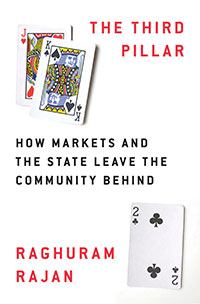Fixing Capitalism

Raghuram Rajan
The Third Pillar:
How Markets and
the State Leave the
Community Behind
Penguin Press
New York, 2019, 464 pp., $30.00
Markets and the state have long competed to control what Lenin called the commanding heights of the economy. After the Berlin Wall fell, markets seemed to reign supreme. Even many on the left, traditional supporters of a strong state, became champions of free markets. The brilliant economist Larry Summers professed “grudging admiration” for Milton Friedman and, while at the US Treasury in the 1990s, pushed for financial globalization, the free flow of capital across national borders.
Raghu Rajan never succumbed to the euphoria. While a firm believer in free markets and their benefits, he has been vocal about their costs. In Saving Capitalism from the Capitalists he wrote that the victims of competition should get help to ease their pain and secure their future: “Markets need a heart for their own good.” In 2005, in a now-famous speech, he warned that the excesses of financial globalization raised the odds of a “catastrophic meltdown,” earning a rebuke from Summers that Rajan was “slightly Luddite” and “largely misguided.”
The global financial crisis and recent discontent with globalization have proved Rajan prescient. His latest book attempts to go beyond warning of the dangers of unfettered capitalism to what can be done to fix it. Rajan suggests restoring the third pillar of society, the community, which he defines as a social group residing in a specific area that shares government and often a common heritage. Markets and the state remain indispensable, but “when the three pillars of society are appropriately balanced” … “society has the best chance for providing for its people,” particularly those who lose out from the effects of trade and technology.
Rajan points up the damage from international trade. US job loss from increased foreign competition, for instance, has contributed to lowering the life expectancy of middle-aged non-Hispanic white males. “It is as if ten Vietnam wars were simultaneously taking place, not in some faraway land, but in homes in small-town and rural America,” Rajan writes. Yet these communities’ fate was largely neglected by the mainstream establishment parties, who Rajan laments “do not even admit to the need for change” and tend to castigate losers from the effects of trade and technology as belonging to a basket of deplorables.
Rajan of course knows that communities too can pose dangers. The book contains a fascinating account of how markets and the state overcame the shortcomings of feudal communities, which provided stability but did little to spare most from abject poverty. Modern communities also erect walls, and overemphasis on tradition and fear of strangers and new ideas can leave people “trapped by the past.”
Still, Rajan argues, markets and the state have usurped communities’ power, and the balance needs to be reset. Power must devolve from global and national levels to the community. Rajan notes that as machines and robots begin to produce more of our goods and services, human work “will center once again around inter-personal relationships.” Communities could well be the workplace of tomorrow.
Opinions expressed in articles and other materials are those of the authors; they do not necessarily reflect IMF policy.









